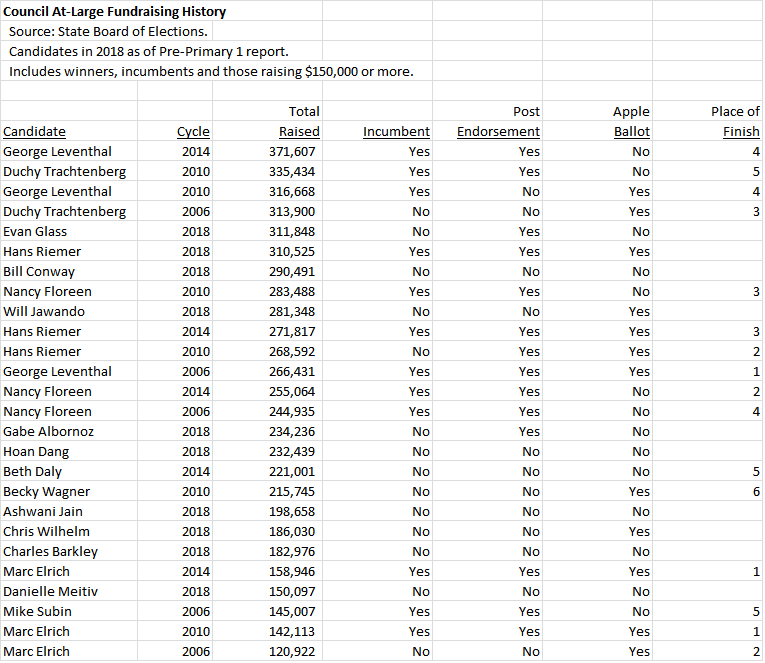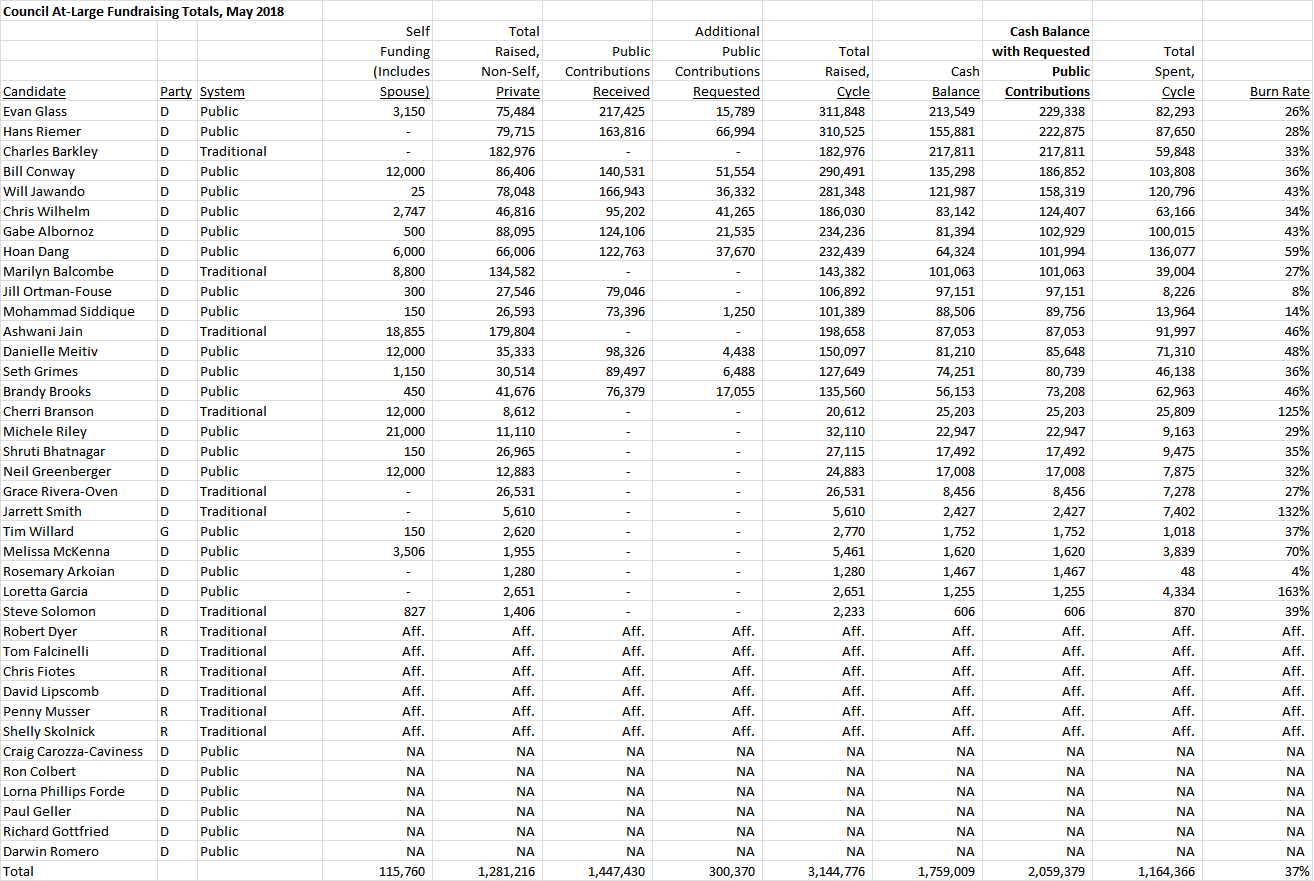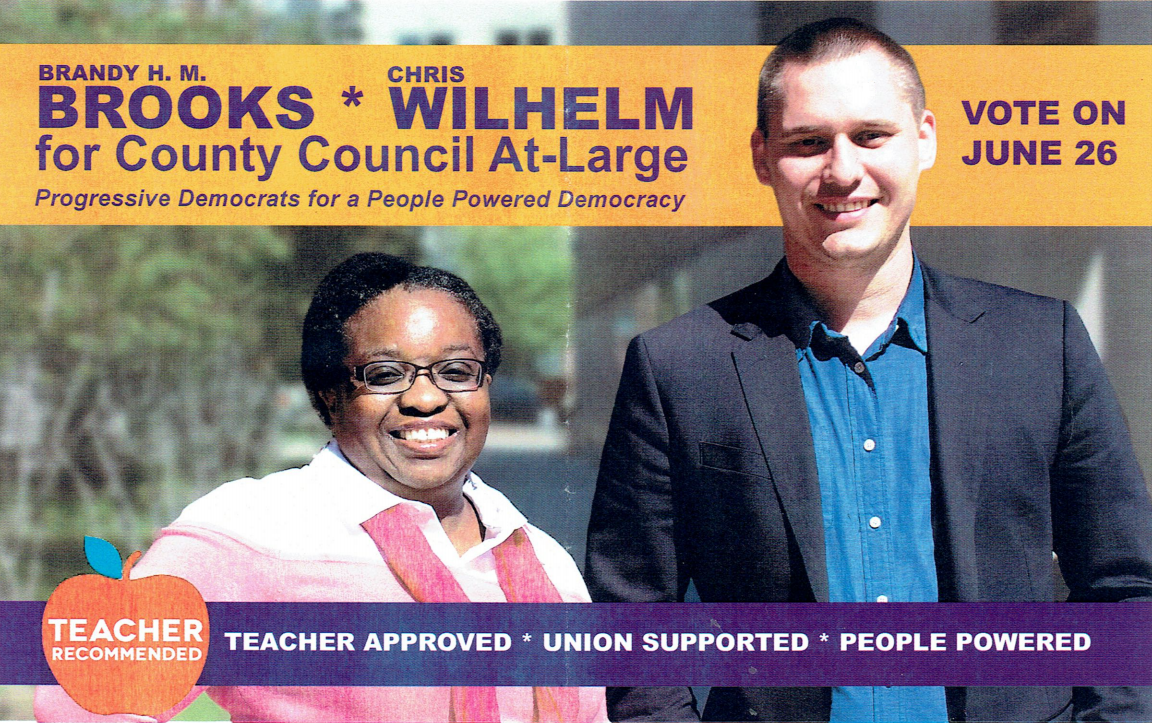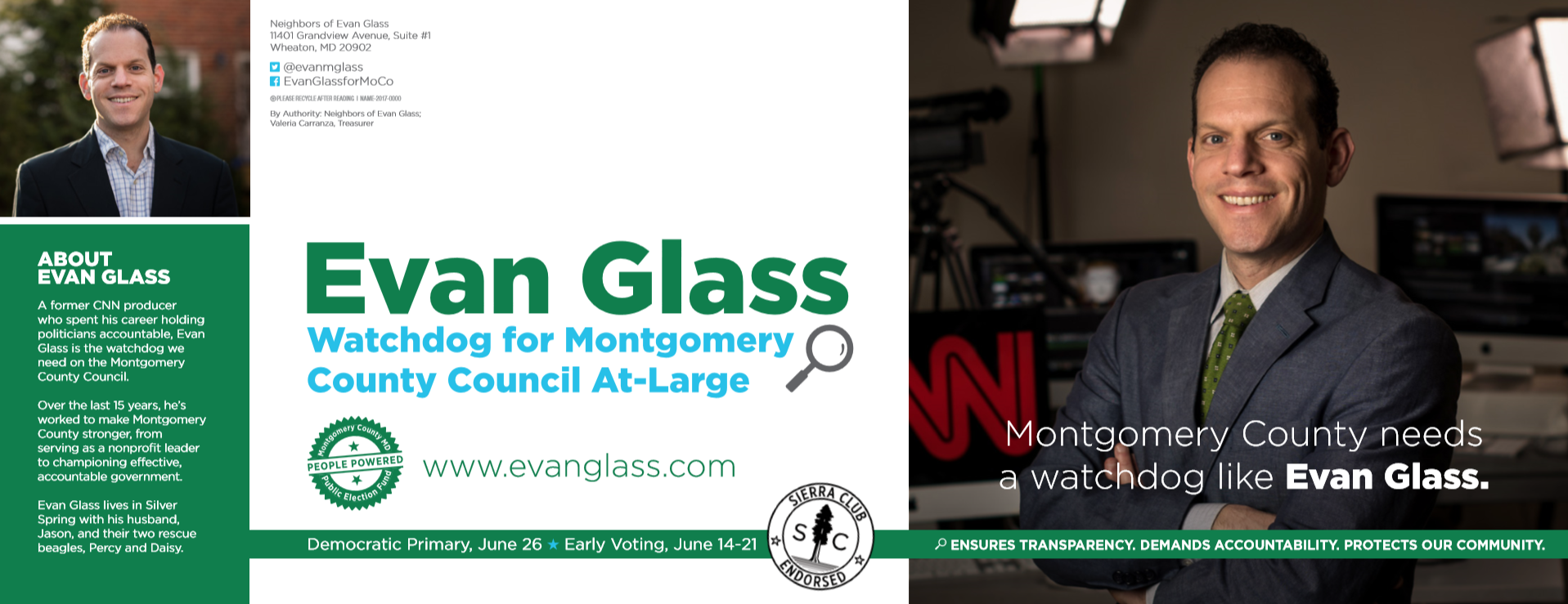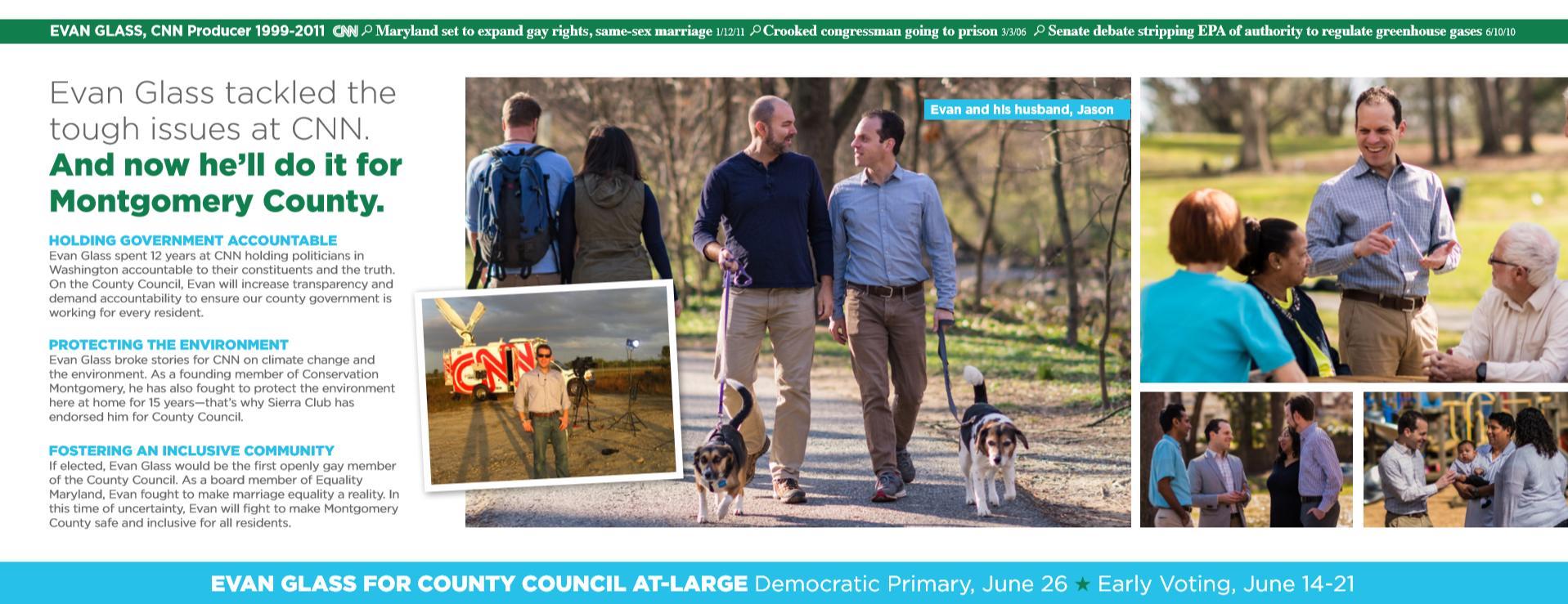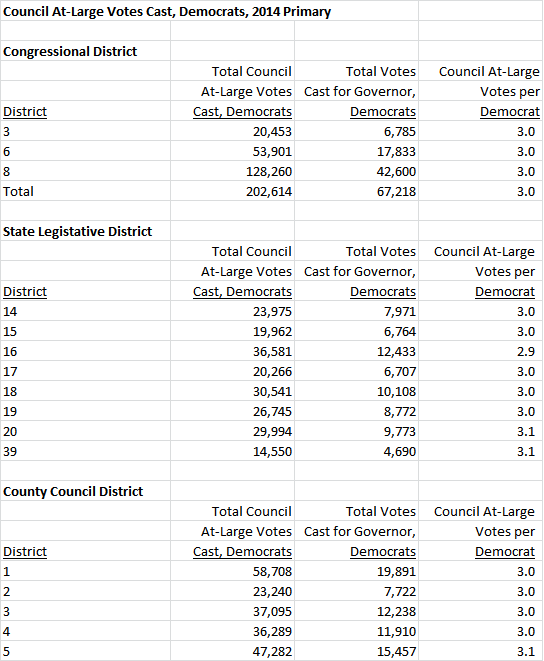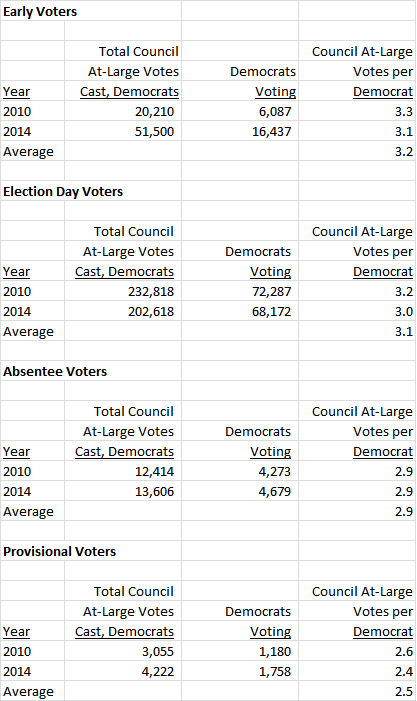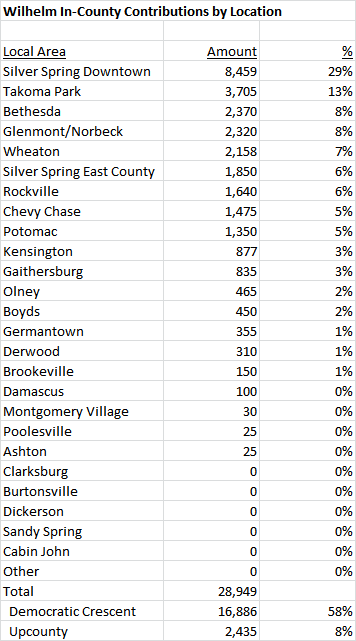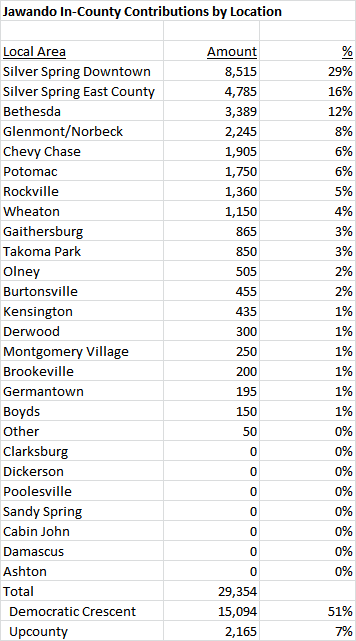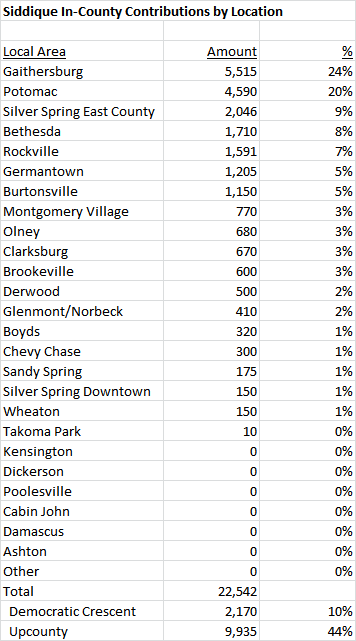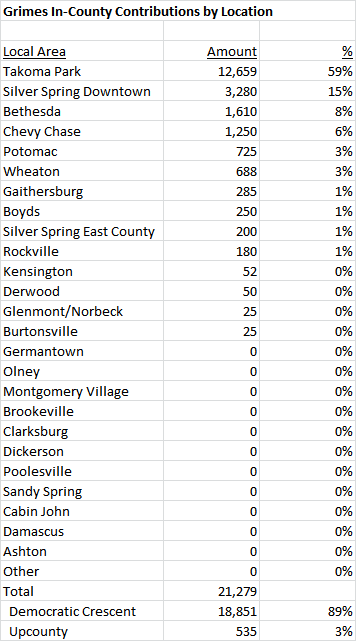Council At-Large candidates Brandy Brooks and Chris Wilhelm, who are running as a team, released this video on behalf of their candidacies.
Category Archives: Council At-Large
Council At-Large Fundraising History
By Adam Pagnucco.
Last week, we wrote about fundraising in the Council At-Large race. Today we put that in perspective. How do today’s campaigns compare to the campaigns of the past?
There are two big differences between this year’s Council At-Large race and its three predecessors: 2006, 2010 and 2014. The first is the presence of public financing. The second is the number of open seats. In 2006, there was one open seat vacated by Steve Silverman, who ran for County Executive. In 2010 and 2014, all four incumbents ran again. This year, there are three at-large vacancies – something that has never happened before.
One thing that all four cycles have in common is the importance of fundraising. Public financing may have changed the mode by which fundraising occurs, but it did not reduce the centrality of fundraising to the prospect of winning. Raising a lot of money doesn’t guarantee success, but it’s hard to win without it!
Below is a chart showing fundraising for Council At-Large candidates over the last four cycles. Candidates shown include incumbents, winners and all others raising at least $150,000. Contributions to 2018 candidates go through the Pre-Primary 1 report, which was due on May 22. Incumbency, endorsements by the Washington Post and MCEA and place of finish are also shown.
Since 2006, all candidates who raised at least $240,000 won with one exception: Duchy Trachtenberg. In 2010, Trachtenberg – then a first-term incumbent – committed one of the craziest decisions of all time by sitting on $146,000. Rumor had it that she had polls showing her winning and had decided to save her money for a future race, perhaps for Executive. Her fellow incumbent, George Leventhal, edged her out for the fourth spot by 3,981 votes. If Trachtenberg had spent her full sum, she might have been able to send out at least another three mailers and history could have changed.
On the other side, no one raising less than $230,000 has won since 2006 with one exception: Marc Elrich. Love him or hate him, Elrich is the exception to a lot of rules in MoCo politics and he has always vastly outperformed his fundraising. Becky Wagner (2010) and Beth Daly (2014) were good candidates but they couldn’t quite raise enough money to break through, even with substantial self-financing.
This year, the folks whose fundraising is in the same ballpark as prior winners are Hans Riemer (the race’s sole incumbent), Evan Glass, Bill Conway and Will Jawando. Gabe Albornoz and Hoan Dang are close. The others on this chart are below Daly and Wagner. All of this year’s candidates will raise a bit more money because these figures only go through a month before the primary. But those in public financing – everyone except Delegate Charles Barkley and Ashwani Jain – have already raised most of their funds for this cycle. Public financing does not allow for last-second $50,000 loans or bundled corporate checks to pay for a final mailer or two.
Money isn’t everything – just ask David Trone. But it has a role and public financing has not changed that. As we go down to the wire in the at-large race, money matters as much as ever.
Campaign Finance Reports: Council At-Large, May 2018
By Adam Pagnucco.
Today, we look at the Council At-Large candidates. As with yesterday, we start with a note on methodology. First, we calculate total raised and total spent across the entire cycle and not just over the course of one report period. Second, we separate self-funding from funds raised from others. Self-funding includes money from spouses. Third, for publicly financed candidates, we include public matching fund distributions that have been requested but not deposited in raised money and in the column entitled “Cash Balance With Requested Public Contributions.” That gives you a better idea of the true financial position of publicly financed campaigns.
Below is our fundraising summary for the Council At-Large candidates.
First, a few random notes. As of this writing, five at-large candidates – Craig Carozza-Caviness, Ron Colbert, Paul Geller, Richard Gottfried and Darwin Romero – have not filed May reports. Lorna Phillips Forde did file a May report and requested matching funds, but her report contains many duplicated entries and is a big mess. We are not printing her numbers until they get straightened out. Michele Riley has given herself a combined $21,000 in two loans and one contribution, which exceeds the $12,000 self-funding maximum allowed in public financing. That needs to be corrected or otherwise remedied.
Now to the numbers. In the pre-public financing days, winning at-large candidates generally raised $250,000 or more with the notable exception of Marc Elrich. Four candidates are in that territory: Hans Riemer (the only incumbent), Evan Glass, Bill Conway and Will Jawando. Gabe Albornoz and Hoan Dang are not far off. Delegate Charles Barkley (D-39) has not raised quite that much, but he started with a big war chest built over years of little competition in his district. The cash on hand leaders are Glass, Riemer and Barkley, who are virtually tied, followed by Conway and then Jawando.
In evaluating differences in cash position, we don’t find variances of $20,000-30,000 very significant. That’s because candidates schedule their expenditures differently. Some have spent a bit more before the deadline and some held back to show a bigger balance. What we do find significant is the difference between candidates who have close to $200,000 available for the final push – Riemer, Glass, Barkley and Conway – and those who have half that amount or less, such as Albornoz, Dang, Marilyn Balcombe, Jill Ortman-Fouse, Mohammad Siddique, Ashwani Jain, Danielle Meitiv, Seth Grimes and Brandy Brooks. (Forget about those who have $25,000 or less.) The latter group of candidates now faces very tough decisions on resource usage. A mailer to super-Dems can cost $35,000-$45,000 depending on how the universe is defined. So a candidate with $100,000 on hand might be able to squeeze out two or three mailers and that’s about it. Is that enough to stand out given all the other races going on?
Institutional endorsements also play a role. Several of the lesser funded candidates, especially Brooks and Meitiv, have some good endorsements that could help them. We think the biggest beneficiary will be MCPS teacher Chris Wilhelm, who has more cash on hand than Albornoz, Dang and Balcombe and also has the Apple Ballot. If the teachers mail for Wilhelm, that could effectively close the gap a bit between him and the top-funded candidates.
For what it’s worth, the conventional wisdom is that Riemer will be reelected, Glass and Jawando will join him and the last seat will come down to Conway or Albornoz. We’re not ready to buy that for a couple reasons. First, among the seven County Councils that have been elected since the current structure was established in 1990, only one – the 1998-2002 council – had zero at-large female members. Combine that with the fact that 60% of the primary electorate is female and it’s premature to write off all the women running. Second, this is an unprecedented year. We have never had public financing before and we have never had so many people running at-large. What seems like conventional wisdom now could seem very unwise in the blink of an eye! So we expect surprises in this historic election.
Next: the council district races.
Joe Biden Endorses Ashwani Jain
Former Vice President Joe Biden has endorsed Council At-Large candidate Ashwani Jain. We reprint Jain’s press release below.
*****
FOR IMMEDIATE RELEASE
May 23, 2018
CONTACT:
Jaan Williams
Campaign Manager
Vice President Joseph R. Biden, Jr. Endorses Ashwani Jain for Montgomery County Council, At-Large
Silver Spring, Md. (May 23, 2018) — Today, Friends of Ashwani Jain announced that Vice President Joseph Biden has endorsed Ashwani Jain, Democratic candidate for an At-Large seat on the Montgomery County Council. Biden is the former Vice President of the United States in the Obama Administration and previously served as a U.S. Senator from the state of Delaware from 1973 to 2009.
“I am humbled and proud to be endorsed by former Vice President Joe Biden,” said Ashwani Jain. “Working for him on the Cancer Moonshot at the White House was truly an incredible experience, and being a part of his team was one of the proudest moments of my life. I’m honored to follow his example as a kind, compassionate, tireless advocate and public servant as I run for Montgomery County Council, At-Large.”
“I have seen first-hand Ashwani Jain’s commitment to his community and our nation, and I am proud to endorse him for an At-Large seat on the Montgomery County Council,” said Vice President Biden. “He is a first-generation American and a 15-year cancer survivor who worked with me in the Administration on the Cancer Moonshot, an issue close to his heart and one that affects so many families in our community. Ashwani understands that to have a strong economy and build the middle class we must work together and ensure equal access to opportunity.”
Ashwani Jain served on the Vice President’s team working on the first ever 50-state Cancer Moonshot Summit. Jain worked with the former Vice President, medical professionals, and researchers nationally and in Montgomery County – at the National Institutes of Health, the National Cancer Institute and Walter Reed Medical Center – in the successful creation of the program. Jain previously served in the Obama-Biden Administration as the Associate Director of External Affairs at the U.S. Department of Health and Human Services, the Deputy White House Liaison at the U.S. Department of Housing and Urban Development, and in the White House Office of Presidential Personnel.
###
Brooks and Wilhelm Campaign as Team Progressive
By Adam Pagnucco.
Council At-Large candidates Brandy Brooks and Chris Wilhelm, both of whom have been endorsed by numerous progressive organizations, have produced a joint lit piece in which they call themselves #TeamProgressive. Candidates in public financing, like Brooks and Wilhelm, cannot be members of slate committees. But nothing in the public financing law prohibits them from producing joint lit with multiple authority lines, as this piece is. This is the first joint lit piece we have seen in the council at-large race.
Evan Glass, Watchdog
By Adam Pagnucco.
Council At-Large candidate Evan Glass has sent out a mailer drawing on his journalistic background and saying he will be a watchdog if elected. We could use a watchdog in the aftermath of the Silver Spring Transit Center fiasco! We are particularly amused by Glass’s citation of a story on which he worked called “Crooked congressman going to prison.” We think incoming Council President Nancy Navarro should establish a new council committee to investigate crooked congressmen and make Glass its chair. It will be the busiest committee at the council by far!
Council At-Large Undervoting, Part Two
By Adam Pagnucco.
In Part One, we learned that even though voters can vote for up to four Council At-Large candidates, they vote for only three on average. Today we examine whether that statistic varies based on geography.
The chart below shows the total number of Council At-Large votes cast in the 2014 Democratic primary, the total number of Democratic votes for Governor and the ratio between the two from precinct votes on Election Day. (Precinct-level turnout numbers from the state include early voters, absentee voters and provisional voters, distorting their use as a denominator, so we used votes for Governor as a proxy for Election Day voters by precinct.) On average, each Democratic voter cast three votes for Council At-Large candidates. That statistic varied very little between Congressional districts, state legislative districts and council districts.
Let’s take a deeper dive and look at local areas. Again, there is minimal variation. A mild outlier is Precinct 11-00 in Dickerson, home of at-large challenger Beth Daly. Was there some undervoting there for Daly and her 2014 teammate, at-large incumbent Marc Elrich? (The two finished first and second in that precinct and smoked everyone else.) One note: the term Democratic Crescent refers to Cabin Branch, Bethesda, Chevy Chase, Kensington, Downtown Silver Spring and Takoma Park, areas which tend to exert disproportionate impact on Democratic primaries.
Over and over, we have seen that the average Democratic primary voter casts three votes for Council At-Large candidates. That statistic has been stable over time and does not vary much by voting mode (early, election day, absentee or provisional), geography, presence of open seats or candidate count. We see no reason why it would be significantly different in this election. What does that mean?
One obvious implication relates to one of the hottest places to find votes in a MoCo primary: the Downcounty areas of Downtown Silver Spring, Takoma Park and nearby locations to the north and northeast. Hans Riemer, Evan Glass, Will Jawando, Danielle Meitiv, Chris Wilhelm, Brandy Brooks, Seth Grimes, Cherri Branson, Jill Ortman-Fouse and Jarrett Smith are among the candidates who are from there and/or are running hard there. If each voter is only voting for three at-large candidates, there simply are not enough votes to go around for all of the above candidates. Who emerges from that scrum?
Riemer ought to finish first in that area. He is not just the only incumbent in the race; he also finished second in Downtown Silver Spring, Takoma Park and Kensington to Marc Elrich in 2014, his best places of finish anywhere in the county. The next tier might be Glass, Jawando, Ortman-Fouse and Grimes, all of whom have done well in prior races in that area. How many votes are available there for anyone else?
One of the greatest challenges of running for Council At-Large is how to allocate scarce resources across a vast county-wide electorate in the face of lots of competition and other draws on voters’ attention. Those candidates who successfully target the voters who align with their values, message, bio and (in some instances) demographic will have a leg up on their less strategic rivals. With only three at-large votes per voter, the premium on strategic engagement is higher than ever. It might just be decisive in an exciting and historic race.
Council At-Large Undervoting, Part One
By Adam Pagnucco.
In the Montgomery County Council At-Large race, voters can vote for up to four candidates and the leading four vote-getters win. That gives candidates a lot of ways to get votes. A common statement heard from candidates is, “You have four votes to cast. There are a lot of good candidates in this race. I hope I can earn one of your votes.”
But that statement, while politically appealing, doesn’t actually reflect the reality of at-large voting. Lots of voters don’t cast four votes in the at-large race. On average, they cast only three.
The chart below shows the total number of Council At-Large votes cast in Democratic primaries and the total number of Democrats voting over the last five cycles. If everyone was casting four at-large votes, the number of at-large votes divided by the number of voters should be four. Instead, the ratio of at-large votes to voters ranges from 3.0 to 3.2, averaging 3.1. That tight range holds regardless of the number of candidates running and the presence of open seats.
What about the timing of votes? The conventional wisdom is that early voters are unusually well informed, know exactly who they’re voting for and can’t wait to vote. If anyone would be willing and able to use all four of their at-large votes, it should be early voters. But in fact, that isn’t true. There is not much difference between early voters, election day voters and absentee voters in terms of how many at-large votes they cast. All of them are right around three each, with provisional voters coming in near 2.5.
Why does this happen? Now we’re in the realm of speculation. Here is a theory. For all its importance to the function of county government, the Council At-Large race is seen by many as a down-ballot affair. It doesn’t attract the attention of races for Congress, Governor and Executive. It competes with state legislative and council district races in the voters’ mail, Facebook feeds and email inboxes. The name recognition of incumbents is modest. (How many voters can actually name all their Council Members?)
Now think about the voting process of the average voter. Perhaps the voter was aided by At-Large Incumbent X in some way, maybe through constituent service or a vote on a bill, master plan or budget item. The voter really likes X and will vote for him. Next, perhaps a voter will pick At-Large Candidate Y because she was endorsed by the Washington Post, the teachers or the Sierra Club. And then perhaps the voter will pick At-Large Candidate Z because a neighbor said something nice about him or handed her his lit. Or maybe Z knocked on the voter’s door. Or maybe Z lives in the same community as the voter. Or maybe Z is the only other candidate the voter recognizes. Or maybe… you get the idea. Often, these voting decisions do not involve great strategic deliberation or deep research on the candidates.
But there is one more variable to examine: geography. We have previously written that Democrats in Downcounty areas, especially those in the Democratic Crescent (Cabin Branch, Bethesda, Chevy Chase, Kensington, Downtown Silver Spring and Takoma Park) are much more likely to vote in mid-term primaries than Upcounty Democrats. Do Democrats in Downcounty vote for more at-large candidates than those in Upcounty? We’ll find out in Part Two.
Public Financing Geography, Part Five
By Adam Pagnucco.
We conclude with the remaining five Council At-Large candidates who have qualified for matching funds in public financing.
Chris Wilhelm
Wilhelm, an MCPS teacher, is becoming a progressive darling of the Council At-Large race with endorsements from MCEA, the Laborers, Progressive Maryland and the Democratic Socialists. His contributions are heavily tilted towards the very liberal areas of Downtown Silver Spring and Takoma Park. The question for Wilhelm is whether he can hang with the other strong competitors going for those same votes, especially Hans Riemer, Evan Glass, Will Jawando, Danielle Meitiv and Seth Grimes and find a way to break into the top four. Wilhelm is a smart and passionate campaigner so don’t count him out.
Will Jawando
Jawando is the leading fundraiser in Silver Spring East County, which we define as zip codes 20903, 20904 and 20905. This area overlaps with the section of District 20 in which he performed best in his 2014 race for Delegate. Jawando has put together a long list of institutional endorsements that exceeds even the race’s sole incumbent, Hans Riemer, and includes the Apple Ballot. (He was also endorsed by the Laborers Union shortly after we published the latest list.) Now Jawando has to raise enough money to get the word out and finish the job. If he does, he will become just the second Council Member of color to win an At-Large seat after Ike Leggett left in 2002.
Danielle Meitiv
Meitiv, the famous Free Range Mom, is so far the only female at-large candidate who has qualified for public matching funds. (Shruti Bhatnagar came close but has been ruled ineligible by the State Board of Elections. Brandy Brooks says she has enough contributions to qualify but has not yet filed with the state.) Meitiv’s contribution geography resembles the all-candidate average and is largely based in the Democratic Crescent that is so critical to winning countywide elections. If she continues to raise money, her status as one of the few competitive at-large women will help her in a primary electorate that is nearly 60% female.
Mohammad Siddique
The good news is that Siddique is the second-leading fundraiser in Gaithersburg ($5,515) after George Leventhal ($6,808). The bad news is that he has a minimal presence in Democratic Crescent areas like Chevy Chase, Downtown Silver Spring and Takoma Park that are critical to countywide performance.
Seth Grimes
Grimes, a former Takoma Park City Council Member, has collected a majority of his contributions from the city with relatively little money coming from elsewhere in the county. Takoma Park is not a big enough base from which to win a countywide election by itself. Grimes needs to pick it up elsewhere to have a chance for victory.
Public Financing Geography, Part Four
By Adam Pagnucco.
Let’s start looking at the Council At-Large candidates who have qualified for public matching funds.
Hans Riemer
Riemer, who is finishing his second term, is the only incumbent in the at-large race. His contributions are heavily based in Downtown Silver Spring and Bethesda, the twin poles of Democratic Downcounty politics. He is weaker in places like Rockville and Upcounty. Riemer’s fundraising reflects his smart growth, urban-focused brand and fits the Democratic Crescent nicely. Our hunch is that he will finish first in both Bethesda and Silver Spring en route to his third term in office. (Disclosure: the author was once employed by Riemer.)
Bill Conway
Here is an amazing fact: in a public financing system that includes multi-term incumbents like Riemer, Marc Elrich and George Leventhal, first-time candidate Bill Conway is the number one fundraiser in both Potomac and Chevy Chase. He has also done well in Bethesda. Conway could use more exposure in Silver Spring. If he gets that, he could combine a top two or three performance in Bethesda, Chevy Chase and Potomac with a smattering of votes in other areas and get a ticket to the County Council.
Evan Glass
Second-time candidate Evan Glass, who almost won the District 5 seat four years ago, has a decade-long history of civic leadership in Downtown Silver Spring which is reflected in his fundraising. Glass has raised almost as much money there ($18,573) as has Marc Elrich ($20,763). Glass needs to grow his base, with the logical targets being other areas in District 5 like East County Silver Spring, Burtonsville, Takoma Park and Forest Glen as well as western parts of the Crescent. As it is, he has a good shot to win.
Hoan Dang
Dang is also a second-time candidate, having finished fifth of six candidates in the 2010 District 19 Delegate race despite doing a good job in fundraising. Dang has done pretty well in public financing but he is not dominating anywhere and has not shown a lot of strength in the Crescent. He could use some institutional backing and more support in places like Bethesda and Downtown Silver Spring to increase his chances of victory.
Gabe Albornoz
County Recreation Department Director Gabe Albornoz is by far the leading fundraiser in Kensington, where he has a large base of family and friends. Other than that, he is not among the fundraising leaders in any of the county’s Democratic strongholds. Albornoz has three useful networks: his professional network from his day job, the contacts he has accumulated during his service on the county’s Democratic Central Committee and the supporters of County Executive Ike Leggett, who has endorsed him. Albornoz needs to continue to monetize those networks and get a couple key endorsements, like the Washington Post. If he can do that, he has a path to victory.
We will finish looking at the Council At-Large qualifiers tomorrow.

